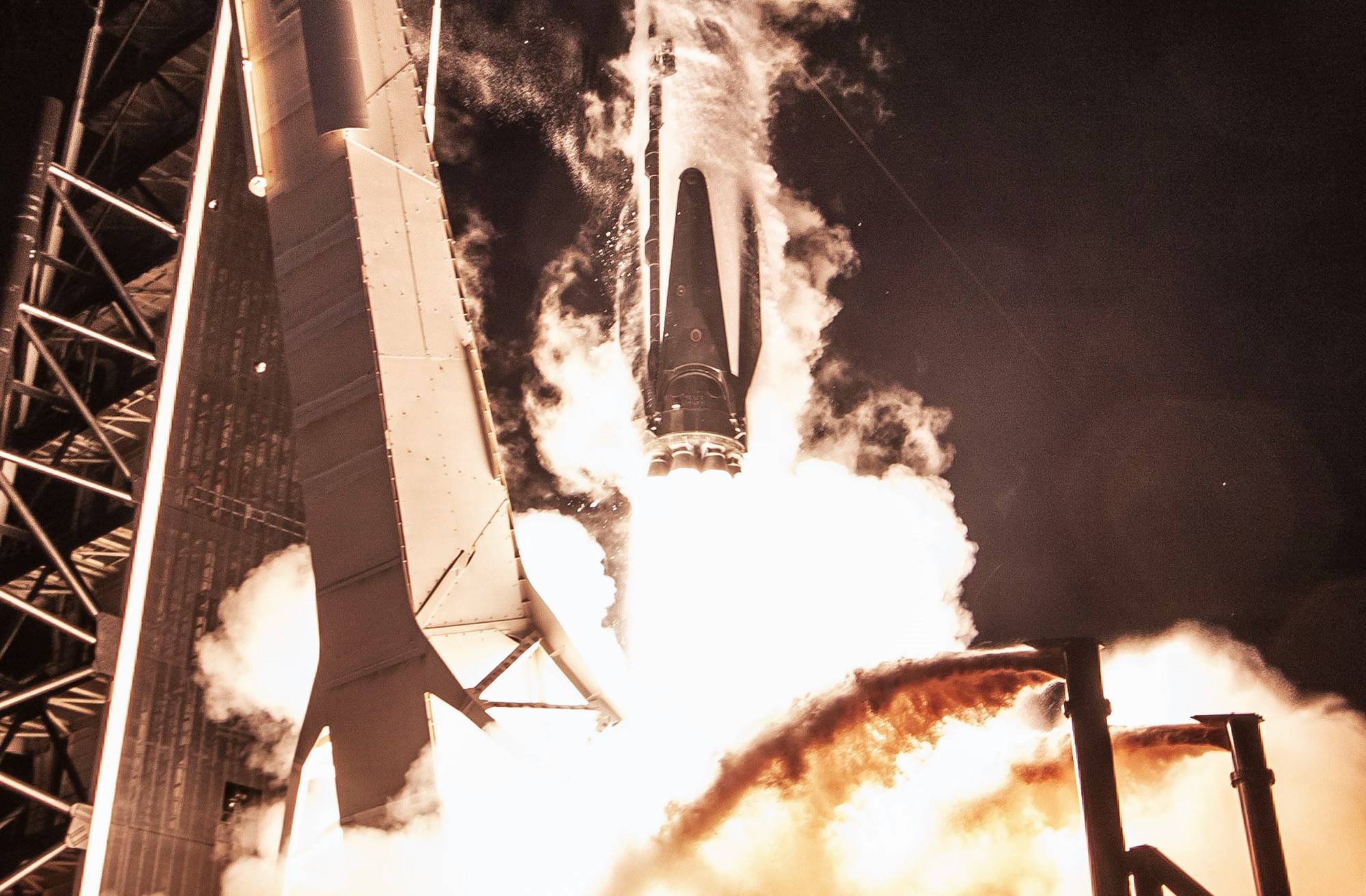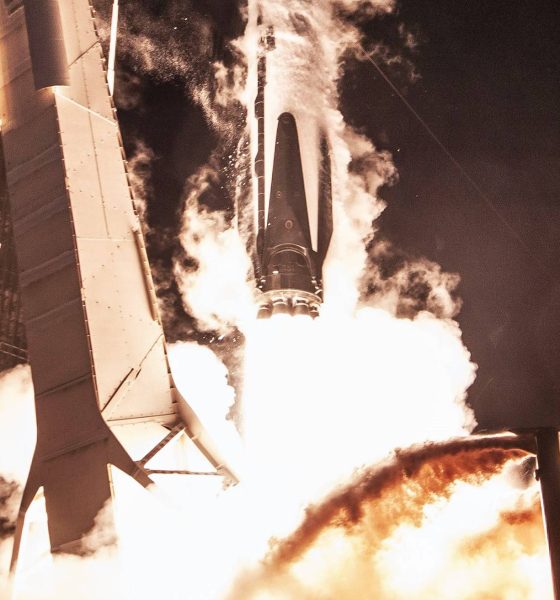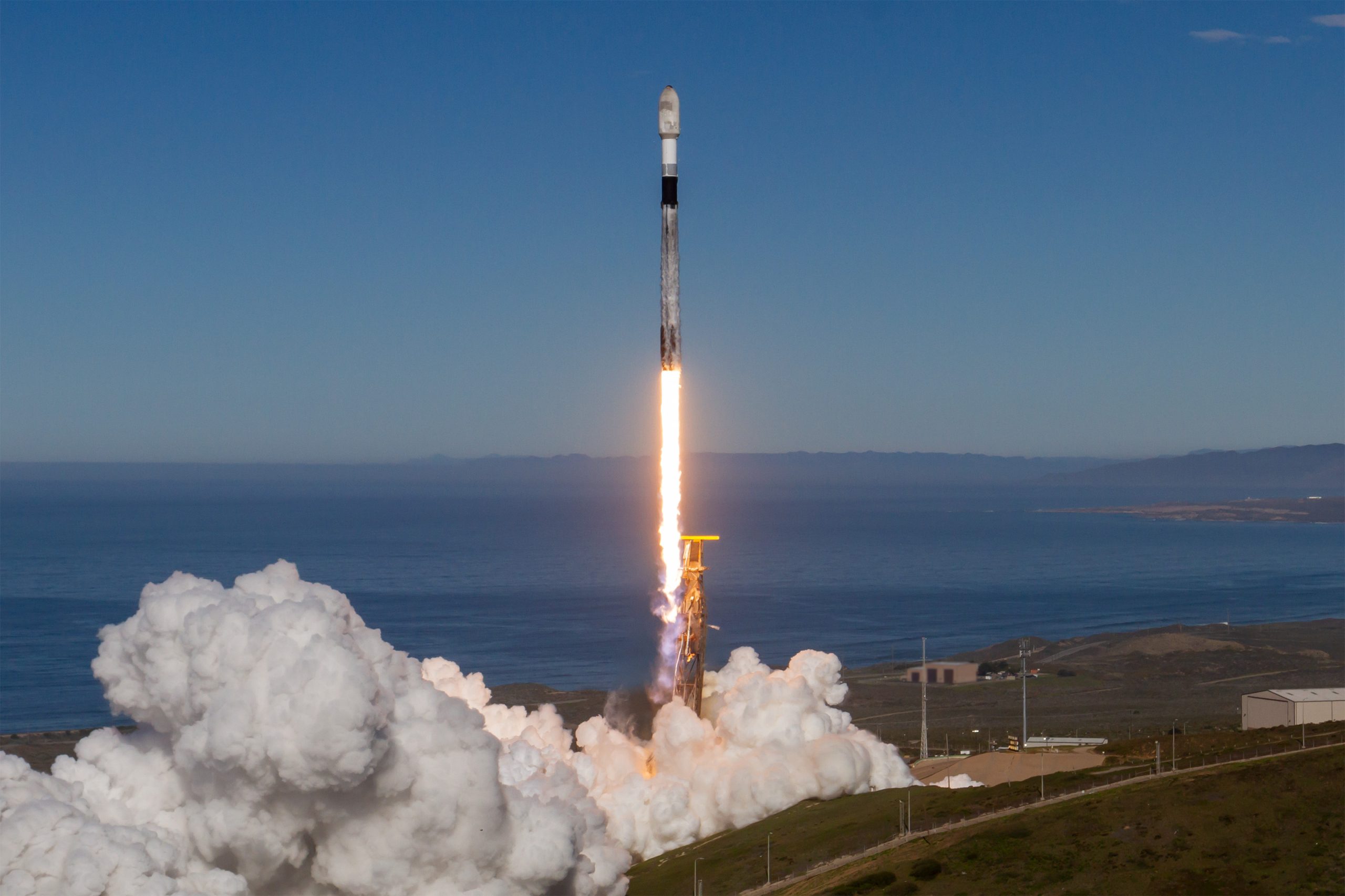

SpaceX
SpaceX’s Falcon 9 to launch new Starlink satellites from Florida this spring
NASASpaceflight.com reports that SpaceX is tentatively on target for the dedicated launch debut of its first (relatively) operational Starlink satellites as early as mid-May, indicating that the company might actually meet an extremely ambitious deadline set last year by CEO Elon Musk.
Although the CEO had briefly hinted that SpaceX would launch at least one additional round of prototype satellites – complementing the two launched in February 2018 – before moving to dedicated Starlink missions, all signs point to this mystery case being a dedicated Falcon 9 launch. Whether or not the aggressive mid-May schedule holds, the first launch of operational Starlink satellites would be a huge milestone for SpaceX’s low Earth orbit (LEO) internet constellation, meant to eventually provide high-quality, affordable broadband access to almost anyone on Earth.
Linking the stars in phases
In November 2018, SpaceX filed a modification to the license it been previously granted by the FCC (Federal Communications Commission) in March, requesting that it be allowed to dramatically change the first phase of its Starlink satellite constellation. In short, SpaceX wanted to find a faster and cheaper way to deploy its first Starlink satellites as quickly as possible.
“[SpaceX] will utilize key elements from its experimental satellites, such as its sophisticated phased-array antennas and its advanced Hall-effect thrusters, as the foundation of a more efficient and cost-effective architecture that can rapidly accelerate deployment for the overall constellation while optimizing space safety.” – Starlink FCC license modification request, SpaceX, 11/8/2018
This modification almost certainly arose as a direct result of CEO Elon Musk’s June 2018 ultimatum, in which he reportedly fired Starlink executives deemed uncooperative in order to rapidly speed up the constellation’s time-to-market. In fact, according to Reuters, Musk challenged the Starlink team to begin launching the constellation’s first operational satellites just one year later (June 2019), an extraordinary aspiration standing a handful of months after the group had launched its first two early satellite prototypes. According to a source
While both sides presumably have good reasons for their stubborn preferences, Musk may well be in the right at the end of the day, particularly given the sheer level of competition to complete LEO internet constellations and begin serving customers. An overly cautious approach could risk being so late to market that multiple competitors, ranging from relatively established entrants OneWeb and Telesat to more obscure companies like WorldVu and Space Norway. Barely a week ago, OneWeb completed the first successful launch of its constellation, placing six demonstration satellites in orbit to prove their technology and reduce risk prior to commencing operational launches with 30+ satellites apiece. Furthermore, both Tesla and SpaceX have more or less flourished while using the same approach, evidenced by a culture of continuous improvement where both electric cars and rocket engines are constantly upgraded and improved upon. Falcon 9 famously features a bevy of versions or “blocks”, culminating recently in Falcon 9 Block 5’s major reusability and reliability optimizations.

A little crazy, but it works
Whether or not Musk can be more than a little crazy, it’s nearly impossible to coherently deny the fact that his strategy of delivering a minimum viable product as quickly as possible and gradually improving it over time has a polished record of success. Once again, Falcon 9 is the best and most relevant example in the context of Starlink. SpaceX’s now-workhorse rocket began in a form (Falcon 9 V1.0) nearly unrecognizable compared to its most recent edition, featuring far less performance, no reusability, and an older and less capable version of Merlin. Falcon 9 V1.1 was a radical – almost clean-sheet –
In short, when Elon Musk and other SpaceX engineers originally conceived of Falcon 9 in the early 2000s, 2018’s Falcon 9 Block 5 was effectively the rocket they were imagining. Rather than spending countless hundreds of millions of dollars to privately design, test, and redesign multiple prototype iterations, Musk et al built a minimum viable product, began launching payloads for paying customers (both government and commercial), and used the company’s reputation, commercial success, and flight experience to shape Falcon 9 into the industry leader it is today.
Put simply, there is no reason to think that the same approach will not prove equally fruitful when applied to satellites instead of rockets. While SpaceX has yet to receive an FCC grant for its Starlink modification request, the company summarized its updated strategy in the November 2018 filing. The request effectively “relocates” the first phase of its 4,425 (now 4209) satellite LEO constellation, moving 1584 satellites from an 1100 km to 550 km orbit and simplifying the design of the first operational spacecraft by using just one spectrum segment (Ku-band) instead of two (Ku- and Ka-band). Hardware to exploit that additional spectrum will be developed and added to Starlink satellites and ground hardware down the road. As such, regardless of how unrefined SpaceX’s first operational Starlink satellites could be, the launch will be just as much of a milestone.

SpaceX will also be able to demonstrate a truly unique aspect of Starlink that helps bolsters its competitive advantage: vertically integrated production and launch of its satellites. Based on FCC permit requests filed last month, SpaceX plans to conduct the first dedicated launch from its Florida-based LC-40 pad, with the Falcon 9 booster landing more than 600 km (370 mi) offshore on drone ship
In other words, Starlink’s operational debut could very well be the heaviest payload SpaceX has yet to launch on a single mission. Weighing less than 500 kg apiece with a dispenser (per Iridium NEXT) around 10% of the total payload mass, SpaceX will likely launch anywhere from 20-40 Starlink satellites at once, depending on the final mass of these first spacecraft and their custom-built dispenser. While delays from the late-April to mid-May launch target are arguably quite likely, the fact that the first operational Starlink launch is tentatively scheduled even less than half a year away bodes very well for tangible constellation progress in 2019.
Check out Teslarati’s Marketplace! We offer Tesla accessories, including for the Tesla Cybertruck and Tesla Model 3.

Elon Musk
Elon Musk gives nod to SpaceX’s massive, previously impossible feat
It was the booster’s 30th flight, a scenario that seemed impossible before SpaceX became a dominant force in spaceflight.

Elon Musk gave a nod to one of SpaceX’s most underrated feats today. Following the successful launch of the Transporter-15 mission, SpaceX seamlessly landed another Falcon 9 booster on a droneship in the middle of the ocean.
It was the booster’s 30th flight, a scenario that seemed impossible before SpaceX became a dominant force in spaceflight.
Elon Musk celebrates a veteran Falcon 9 booster’s feat
SpaceX completed another major milestone for its Smallsat Rideshare program on Friday, successfully launching and deploying 140 spacecraft aboard a Falcon 9 from Vandenberg Space Force Base. The mission, known as Transporter-15, lifted off two days later than planned after a scrub attributed to a ground systems issue, according to SpaceFlight Now. SpaceX confirmed that all payloads designed to separate from the rocket were deployed as planned.
The Falcon 9 used for this flight was booster B1071, one of SpaceX’s most heavily flown rockets. With its 30th mission completed, it becomes the second booster in SpaceX’s fleet to reach that milestone. B1071’s manifest includes five National Reconnaissance Office missions, NASA’s SWOT satellite, and several previous rideshare deployments, among others. Elon Musk celebrated the milestone on X, writing “30 flights of the same rocket!” in his post.
Skeptics once dismissed reusability as unfeasible
While rocket landings are routine for SpaceX today, that was not always the case. Industry veterans previously questioned whether reusable rockets could ever achieve meaningful cost savings or operational reliability, often citing the Space Shuttle’s partial reusability as evidence of failure.
In 2016, Orbital ATK’s Ben Goldberg argued during a panel that even if rockets could be reusable, they do not make a lot of sense. He took issue with Elon Musk’s claims at the time, Ars Technica reported, particularly when the SpaceX founder stated that fuel costs account for just a fraction of launch costs.
Goldberg noted that at most, studies showed only a 30% cost reduction for low-Earth orbit missions by using a reusable rocket. “You’re not going to get 100-fold. These numbers aren’t going to change by an order of magnitude. They’re just not. That’s the state of where we are today,” he said.
Former NASA official Dan Dumbacher, who oversaw the Space Launch System, expressed similar doubts in 2014, implying that if NASA couldn’t make full reusability viable, private firms like SpaceX faced steep odds.
Elon Musk
SpaceX’s Starship program is already bouncing back from Booster 18 fiasco
Just over a week since Booster 18 met its untimely end, SpaceX is now busy stacking Booster 19, and at a very rapid pace, too.

SpaceX is already bouncing back from the fiasco that it experienced during Starship Booster 18’s initial tests earlier this month.
Just over a week since Booster 18 met its untimely end, SpaceX is now busy stacking Booster 19, and at a very rapid pace, too.
Starship V3 Booster 19 is rising
As per Starbase watchers on X, SpaceX rolled out the fourth aft section of Booster 19 to Starbase’s MegaBay this weekend, stacking it to reach 15 rings tall with just a few sections remaining. This marks the fastest booster assembly to date at four sections in five days. This is quite impressive, and it bodes well for SpaceX’s Starship V3 program, which is expected to be a notable step up from the V2 program, which was retired after a flawless Flight 11.
Starship watcher TankWatchers noted the tempo on X, stating, “During the night the A4 section of Booster 19 rolled out to the MegaBay. With 4 sections in just 5 days, this is shaping up to be the fastest booster stack ever.” Fellow Starbase watcher TestFlight echoed the same sentiments. “Booster 19 is now 15 rings tall, with 3 aft sections remaining!” the space enthusiast wrote.
Aggressive targets despite Booster 18 fiasco
SpaceX’s V3 program encountered a speed bump earlier this month when Booster 18, just one day after rolling out into the factory, experienced a major anomaly during gas system pressure testing at SpaceX’s Massey facility in Starbase, Texas. While no propellant was loaded, no engines were installed, and no one was injured in the incident, the unexpected end of Booster 18 sparked speculation that the Starship V3 program could face delays.
Despite the Booster 18 fiasco, however, SpaceX announced that “Starship’s twelfth flight test remains targeted for the first quarter of 2026.” Elon Musk shared a similar timeline on X earlier this year, with the CEO stating that “ V3 is a massive upgrade from the current V2 and should be through production and testing by end of year, with heavy flight activity next year.”
Considering that Booster 19 seems to be moving through its production phases quickly, perhaps SpaceX’s Q1 2026 target for Flight 12 might indeed be more than feasible.
Elon Musk
Elon Musk shares SpaceX’s directive that destroys a prevalent media narrative
Musk’s comments followed Starlink’s initiatives for people affected by severe flooding in Indonesia and Cyclone Ditwah in Sri Lanka.

Elon Musk recently shared SpaceX’s standing policy to offer free Starlink service during natural disasters worldwide, highlighting the company’s commitment to pursue aid over profit during times of need.
Musk’s comments followed Starlink’s initiatives for people affected by severe flooding in Indonesia and Cyclone Ditwah in Sri Lanka.
Starlink activates free service in Indonesia and Sri Lanka
Starlink recently announced free service for those impacted by severe flooding in Indonesia’s Sumatra region, partnering with the government to deploy terminals rapidly to the hardest-hit areas. The offer extends to new and existing customers through December, restoring connectivity in zones where traditional networks have failed due to infrastructure damage.
Musk quoted the post on X, writing, “SpaceX standard policy is to make Starlink free whenever there is a natural disaster somewhere in the world. It would not be right to profit from misfortune.”
Starlink extended the same relief to Sri Lanka amid Cyclone Ditwah, coordinating with local authorities for additional support. The cyclone battered the island nation with heavy rains and winds, disrupting communications for thousands. Free access also lasts until year-end, emphasizing Starlink’s role in bridging gaps during crises.
“For those affected by the severe flooding in Indonesia and Sri Lanka in the aftermath of Cyclone Ditwah, Starlink is providing free service to new and existing customers through the end of December 2025. We’re also working with the Indonesian government to rapidly deploy terminals and restore connectivity to the hardest-hit areas on Sumatra, as well as with the Sri Lankan government to provide additional assistance,” Starlink wrote in a post on its official website.
Musk’s companies routinely provide aid
Musk’s firms have a track record of providing critical support in crises, often without fanfare, challenging portrayals of him as a comic book villain intent on enriching himself on the backs of a suffering populace. In January 2024 alone, Tesla opened Superchargers for free in Japan’s Hokuriku region after a magnitude 7.6 earthquake killed at least 55 and injured hundreds.
Similar efforts include Starlink deployments for the 2023 Maui wildfires, 2024 Hurricane Helene in North Carolina, and floods in Texas, where the service was used to help facilitate emergency coordination. These actions, which total millions in waived fees and logistics, demonstrate a proactive ethos among Musk’s companies, with Musk noting in past interviews that such aid stems from engineering solutions over optics.
The initiatives also provide a direct rebuttal of Musk’s characterization on mainstream media, which tends to lean negatively. This has become much more notable in recent years as Musk adopted more conservative policies. These negative sentiments came to a head earlier this year when Tesla stores, vehicles, and even some owners, were attacked during waves of anti-Tesla protests.








